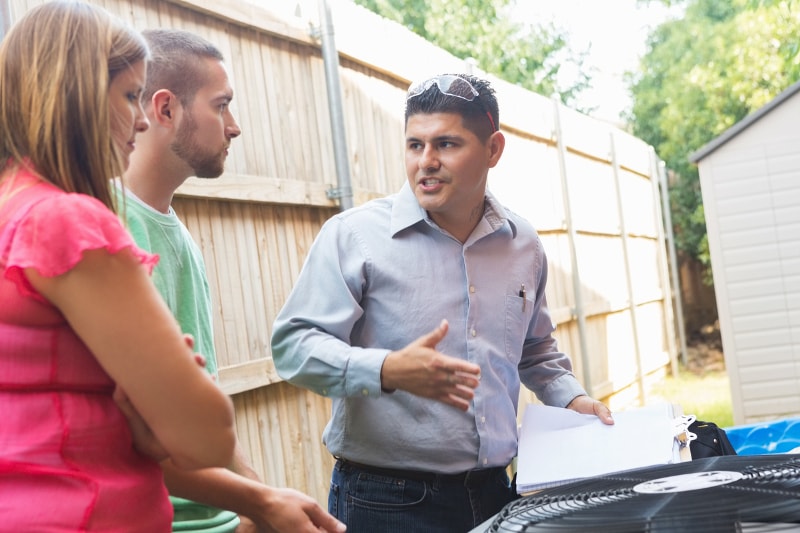Air conditioners were created in 1902, thanks to Willis Haviland Carrier. They have always operated on the same basic principle to cool homes, vehicles and businesses. Read on to learn about how your air conditioner works to cool your Fayetteville, NC, home.
Components of the Air Conditioner
Not many people understand how air conditioners work or the components used in them. The main components of air conditioners are the following:
- The compressor
- The condenser
- The evaporator coil
- The expansion valve
- The refrigerant
The refrigerant, also known as R-401A, moves through the cooling tubes, and as it becomes heated, it becomes a liquid. R22 became illegal to use in the United States on January 1st, 2020. Like a human heart pumps blood, the compressor drives the refrigerant through every component of the air conditioner.
The condenser cools the hot vapor as it goes through the coils. The expansion valve expands the hot vapor. When the gas expands, it cools down.
The evaporator coil component is the part of the air conditioner that cools your home. The more efficient the cooling unit, the faster it cools down your home.
Refrigerant
Refrigerants have a property that allows it to change at low temperatures. They also have very low boiling points, allowing them to change from a liquid to a gas vapor at low temperatures. Since the banning of R22, those who use refrigerants switched to R-401A.
The boiling point for R-401A is -27 degrees Fahrenheit, making it a vital component to a functioning air conditioning system since it doesn’t generate heat on its own. A refrigerant can’t move through the other components on its own and needs a compressor to do so. But first, the refrigerant has to leave the evaporator coil.
Evaporator Coil
The evaporator coil is where everything begins and ends. The evaporator coil is cold and has low pressure, meaning that the refrigerant inside is in its liquefied state. At the beginning of the cycle, hot air flows over the evaporator coils, and the refrigerant then absorbs the hot air.
Since the boiling point for the refrigerant is at -27 degrees Fahrenheit, it quickly becomes a hot gas. A hot gas will not cool off a home, which means that the AC must convert this hot gas back into a cold liquid. To do this, the gas is first sent to the compressor.
Compressor
The compressor puts the gas under high pressure, making it even hotter. This compressor accomplishes this by pressurizing the refrigerant in order to turn it into a liquid. Under high pressure, a refrigerant will change from a gas to a liquid as pressure creates heat.
The compressor is a large pump that not only increases the pressure of the gas, but it also controls the amount of this gas. This pressurization is a step in the process of turning the gas back into a liquid. Refrigerants enter the compressor a warm vapor under low pressure and leave as hot vapor under high pressure.
Condenser Coils
Once the gas vapor goes through the condenser coils, the condenser fan then blows air over the condenser coils to hasten the cooling process. There are thin metal fins that move heat from the coils while the condenser fan does the rest of the work. In turn, this changes the refrigerant from a hot vapor to a hot liquid; the liquid then goes to the expansion valve.
If you are curious as to where in the air conditioner the condenser coils are, they are outside. If you look at any air conditioner, either a window AC unit or otherwise, the noisy part in on the outside houses the compressor, condenser fan and the condenser coil.
Expansion Valve
The expansion valve is the component that does the actual cooling of the heated refrigerant. As the name of the component suggests, the expansion valve expands the gas. When gas compresses, it heats up, but it does the opposite when it expands.
Once the cooled gas leaves the expansion valve, it returns to the evaporator coil and exits through the vents. At the same time the cool air is coming out, the warm air is drawing in, heating the refrigerant once more.
Now that you’ve satisfied your curiosity about how your AC unit works, it’s time to ensure that it’s working properly. If your Fayetteville, NC, air conditioner needs servicing, contact Cape Fear Air, Electric, & Plumbing today for an appointment. We provide reliable customer service for all your needs, whether it is preventative maintenance, emergency repair or installation.
Image provided by iStock




